Navigation
Modeling Disease Outcomes to Help Meet Challenges of Infectious Diseases and Climate Change
Climate change is already affecting the spread of infectious diseases--and human health and biodiversity worldwide--according to disease ecologists reporting research results in the August 2, 2013 issue of the journal Science. Modeling disease outcomes from host and parasite responses to climate variables, they say, could help public health officials and environmental managers address the challenges posed by the changing landscape of infectious disease.
Study highlights challenges of predicting disease outcomes in a warming world
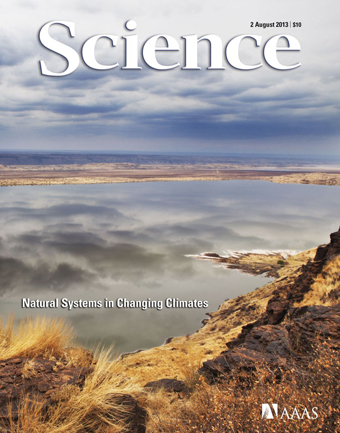 The researchers' findings are described in the August 2, 2013, issue of Science.: Image Credit: Copyright AAAS 2013Climate change is already affecting the spread of infectious diseases--and human health and biodiversity worldwide--according to disease ecologists reporting research results in the August 2, 2013 issue of the journal Science.
The researchers' findings are described in the August 2, 2013, issue of Science.: Image Credit: Copyright AAAS 2013Climate change is already affecting the spread of infectious diseases--and human health and biodiversity worldwide--according to disease ecologists reporting research results in the August 2, 2013 issue of the journal Science.
Modeling disease outcomes from host and parasite responses to climate variables, they say, could help public health officials and environmental managers address the challenges posed by the changing landscape of infectious disease.
"Earth's changing climate and the global spread of infectious diseases are threatening human health, agriculture and wildlife," said Sam Scheiner, National Science Foundation (NSF) program director for the joint NSF-National Institutes of Health Ecology and Evolution of Infectious Diseases Program, which funded the research. Solving these problems requires a comprehensive approach that unites scientists from biology, the geosciences and the social sciences."
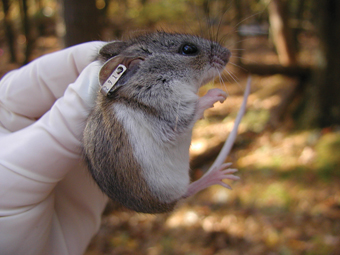 White-footed mice: the primary reservoir hosts for Lyme disease in the eastern United States.: Photograph by R. Ostfeld courtesy of NSF
White-footed mice: the primary reservoir hosts for Lyme disease in the eastern United States.: Photograph by R. Ostfeld courtesy of NSF
“Vectors of human disease are responsive to environmental conditions,” writes Dr. Mary E. Wilson in in the book Water and Sanitation Related Diseases and the Environment: Challenges, Interventions, and Preventive Measures. “The survival, distribution, abundance, and behavior of vectors, such as mosquitoes and ticks, are intimately linked to the landscape, the local ecology, and the physiochemical environment. The built environment also affects vector distribution and behavior, sometimes providing protected niches where vectors can survive.”
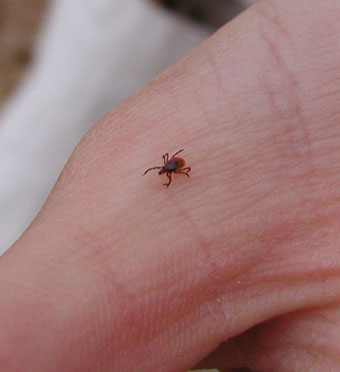 Black-legged ticks, the primary vectors of Lyme disease in the northeastern United States.: Photograph by K. Oggenfuss courtesy of NSF
Black-legged ticks, the primary vectors of Lyme disease in the northeastern United States.: Photograph by K. Oggenfuss courtesy of NSF
According to lead author of the Science article, Sonia Altizer of the University of Georgia, the issue of climate change and disease has provoked intense debate over the last decade, particularly in the case of diseases that affect humans.
In the Science paper, Altizer and her colleagues--Richard Ostfeld of the Cary Institute of Ecosystem Studies; Pieter Johnson of the University of Colorado; Susan Kutz of the University of Calgary and Canadian Cooperative Wildlife Health Centre; and Drew Harvell of Cornell University--laid out an agenda for future research and action.
"For a lot of human diseases, responses to climate change depend on the wealth of nations, healthcare infrastructure, and the ability to take mitigating measures," Altizer said.
"The climate signal, in many cases, is hard to tease apart from other factors like vector control, and vaccine and drug availability."
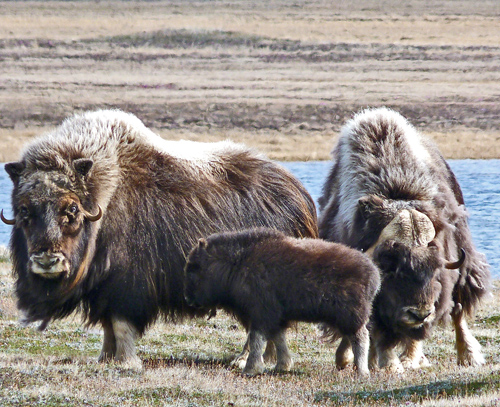 Muskoxen may be susceptible to arctic climate change and emerging infectious diseases.: Photograph by S. Kutz courtesy of NSF
Muskoxen may be susceptible to arctic climate change and emerging infectious diseases.: Photograph by S. Kutz courtesy of NSF
In diseases affecting wildlife and agricultural ecosystems, however, findings show that climate warming is already causing changes.
"In many cases, we're seeing an increase in disease and parasitism," Altizer said. "But the effect of climate change on these disease relationships depends on the physiology of the organisms and on the structure of natural communities."
At the organism level, climate change can alter the physiology of parasites. Some of the clearest examples are found in the Arctic, where temperatures are rising rapidly. Parasites are developing faster as a result. A lungworm that affects muskoxen, for instance, may be transmitted over a longer period each summer, making it a more serious problem for the populations it infects.
Climate change is also affecting
entire plant and animal communities.
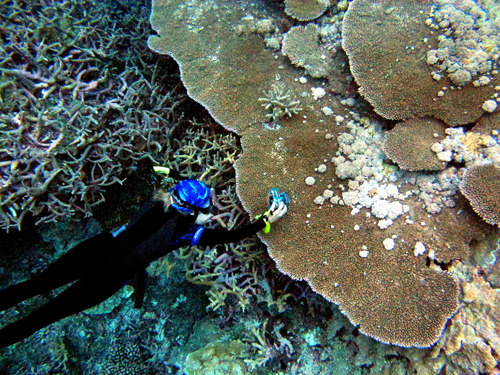 Biologist studying tumors on coral; climate warming may fuel lethal coral diseases.: Photograph by B. Willis courtesy of NSFCommunity-level responses to rising temperatures are evident in tropical marine environments such as the coral reef ecosystems of the Caribbean. Warmer water temperatures have directly stressed corals and facilitated infections by pathogenic fungi and bacteria. When corals succumb, other species that depend on them are affected.
Biologist studying tumors on coral; climate warming may fuel lethal coral diseases.: Photograph by B. Willis courtesy of NSFCommunity-level responses to rising temperatures are evident in tropical marine environments such as the coral reef ecosystems of the Caribbean. Warmer water temperatures have directly stressed corals and facilitated infections by pathogenic fungi and bacteria. When corals succumb, other species that depend on them are affected.
The potential consequences of these changes are serious. The combination of warmer temperatures and altered disease patterns is placing growing numbers of species at risk of extinction, the scientists say.
In human health, there is a direct risk from pathogens like dengue, malaria and cholera. All are linked to warmer temperatures.
Indirect risks also exist in threats to agricultural systems and game species that are crucial for subsistence and cultural activities.
The scientists recommend building on and expanding data on the physiological responses of hosts and parasites to temperature change. Those mechanisms may offer clues to how a system will respond to climate warming.
"We'd like to be able to predict, for example, that if the climate warms by a certain amount, then in a particular host-parasite system we might see an increase from one to two disease transmission cycles each year," Altizer said.
"But we'd also like to try to tie these predictions to actions that might be taken."
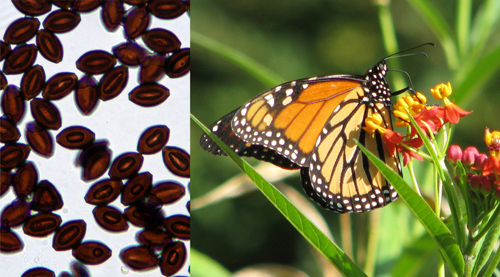 Monarch butterflies carry infections in parts of the U.S. where they breed year-round.: Photograph courtesy of NSF by P. Davis and S. Altizer
Monarch butterflies carry infections in parts of the U.S. where they breed year-round.: Photograph courtesy of NSF by P. Davis and S. Altizer
Some of those actions might involve more monitoring and surveillance, adjusting the timing of vector control measures and adopting new management measures.
These could include, for instance, closing coral reefs to human activity if a disease outbreak is predicted, or changing the planting strategy for crops to compensate for unusually high risks of certain diseases.
The researchers also point out that certain local human communities, such as those of indigenous peoples in the Arctic, could be disproportionately affected by climate-disease interactions.
Predicting where these local-scale effects might be most intense would allow societies to take measures to address issues such as health and food security.
"Involving local communities in disease surveillance," said Altizer, "could become essential."
This news is from the National Science Foundation (NSF), 1 August 2013. Posted on the Horizon International Solutions Site on 5 August 2013.
Related Websites
NSF Special Report: The Ecology and Evolution of Infectious Diseases:http://www.nsf.gov/news/special_reports/ecoinf/index.jsp
NSF News: Controlling the Spread of Diseases Among Humans, Other Animals and the Environment:http://www.nsf.gov/news/news_summ.jsp?cntn_id=125496
NSF Discovery Article Series: Ecology and Evolution of Infectious Diseases:http://www.nsf.gov/discoveries/disc_summ.jsp?cntn_id=127103&org=NSF
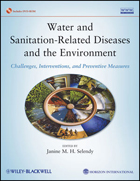 Book CoverThis article is presented as part of the Supplementary Material that accompanies the book Water and Sanitation Related Diseases and the Environment: Challenges, Interventions, and Preventive Measures, a Wiley-Blackwell publication in collaboration with Horizon International, written by 59 experts. Janine M. H. Selendy, Horizon International Founder, Chairman, President and Publisher, is Editor.
Book CoverThis article is presented as part of the Supplementary Material that accompanies the book Water and Sanitation Related Diseases and the Environment: Challenges, Interventions, and Preventive Measures, a Wiley-Blackwell publication in collaboration with Horizon International, written by 59 experts. Janine M. H. Selendy, Horizon International Founder, Chairman, President and Publisher, is Editor.
The book’s 4 hours of multimedia DVDs are included with an abundance of multidisciplinary resources, covering diverse topics from anthropology to economics to global health are being distributed free of charge by the Global Development And Environment Institute (GDAE) at Tufts University.
These will be sent to thousands of libraries, organizations, and institutions in 138 less-wealthy countries and will be invaluable additions to library materials for use in classrooms and communities, by researchers and government decision-makers.
 Map of countries
Map of countries
As of June 25, 2013, these resources have been made available in over 1,200 entities across 55 countries.
Read more: PDF Version is available at http://solutions-site.org/press/release1july2013.pdf
Search
Latest articles
Agriculture
- World Water Week: Healthy ecosystems essential to human health: from coronavirus to malnutrition Online session Wednesday 24 August 17:00-18:20
- World Water Week: Healthy ecosystems essential to human health: from coronavirus to malnutrition Online session Wednesday 24 August 17:00-18:20
Air Pollution
- "Water and Sanitation-Related Diseases and the Changing Environment: Challenges, Interventions, and Preventive Measures" Volume 2 Is Now Available
- Global Innovation Exchange Co-Created by Horizon International, USAID, Bill and Melinda Gates Foundation and Others
Biodiversity
- It is time for international mobilization against climate change
- World Water Week: Healthy ecosystems essential to human health: from coronavirus to malnutrition Online session Wednesday 24 August 17:00-18:20
Desertification
- World Water Week: Healthy ecosystems essential to human health: from coronavirus to malnutrition Online session Wednesday 24 August 17:00-18:20
- UN Food Systems Summit Receives Over 1,200 Ideas to Help Meet Sustainable Development Goals
Endangered Species
- Mangrove Action Project Collaborates to Restore and Preserve Mangrove Ecosystems
- Coral Research in Palau offers a “Glimmer of Hope”
Energy
- Global Innovation Exchange Co-Created by Horizon International, USAID, Bill and Melinda Gates Foundation and Others
- Wildlife Preservation in Southeast Nova Scotia
Exhibits
- Global Innovation Exchange Co-Created by Horizon International, USAID, Bill and Melinda Gates Foundation and Others
- Coral Reefs
Forests
- NASA Satellites Reveal Major Shifts in Global Freshwater Updated June 2020
- Global Innovation Exchange Co-Created by Horizon International, USAID, Bill and Melinda Gates Foundation and Others
Global Climate Change
- It is time for international mobilization against climate change
- It is time for international mobilization against climate change
Global Health
- World Water Week: Healthy ecosystems essential to human health: from coronavirus to malnutrition Online session Wednesday 24 August 17:00-18:20
- More than 400 schoolgirls, family and teachers rescued from Afghanistan by small coalition
Industry
- "Water and Sanitation-Related Diseases and the Changing Environment: Challenges, Interventions, and Preventive Measures" Volume 2 Is Now Available
- Global Innovation Exchange Co-Created by Horizon International, USAID, Bill and Melinda Gates Foundation and Others
Natural Disaster Relief
- STOP ATTACKS ON HEALTH CARE IN UKRAINE
- Global Innovation Exchange Co-Created by Horizon International, USAID, Bill and Melinda Gates Foundation and Others
News and Special Reports
- World Water Week: Healthy ecosystems essential to human health: from coronavirus to malnutrition Online session Wednesday 24 August 17:00-18:20
- STOP ATTACKS ON HEALTH CARE IN UKRAINE
Oceans, Coral Reefs
- World Water Week: Healthy ecosystems essential to human health: from coronavirus to malnutrition Online session Wednesday 24 August 17:00-18:20
- Mangrove Action Project Collaborates to Restore and Preserve Mangrove Ecosystems
Pollution
- Zakaria Ouedraogo of Burkina Faso Produces Film “Nzoue Fiyen: Water Not Drinkable”
- "Water and Sanitation-Related Diseases and the Changing Environment: Challenges, Interventions, and Preventive Measures" Volume 2 Is Now Available
Population
- "Water and Sanitation-Related Diseases and the Changing Environment: Challenges, Interventions, and Preventive Measures" Volume 2 Is Now Available
- "Water and Sanitation-Related Diseases and the Changing Environment: Challenges, Interventions, and Preventive Measures" Volume 2 Is Now Available
Public Health
- Honouring the visionary behind India’s sanitation revolution
- Honouring the visionary behind India’s sanitation revolution
Rivers
- World Water Week: Healthy ecosystems essential to human health: from coronavirus to malnutrition Online session Wednesday 24 August 17:00-18:20
- Mangrove Action Project Collaborates to Restore and Preserve Mangrove Ecosystems
Sanitation
- Honouring the visionary behind India’s sanitation revolution
- Honouring the visionary behind India’s sanitation revolution
Toxic Chemicals
- "Water and Sanitation-Related Diseases and the Changing Environment: Challenges, Interventions, and Preventive Measures" Volume 2 Is Now Available
- Actions to Prevent Polluted Drinking Water in the United States
Transportation
- "Water and Sanitation-Related Diseases and the Changing Environment: Challenges, Interventions, and Preventive Measures" Volume 2 Is Now Available
- Urbanization Provides Opportunities for Transition to a Green Economy, Says New Report
Waste Management
- Honouring the visionary behind India’s sanitation revolution
- Honouring the visionary behind India’s sanitation revolution
Water
- Honouring the visionary behind India’s sanitation revolution
- Honouring the visionary behind India’s sanitation revolution
Water and Sanitation
- Honouring the visionary behind India’s sanitation revolution
- Honouring the visionary behind India’s sanitation revolution

